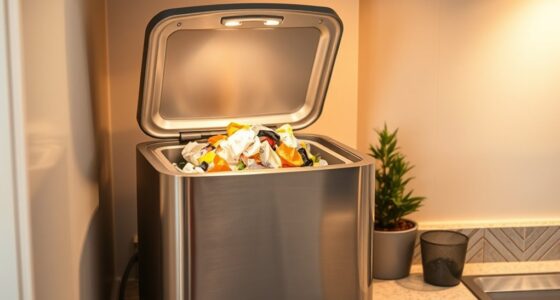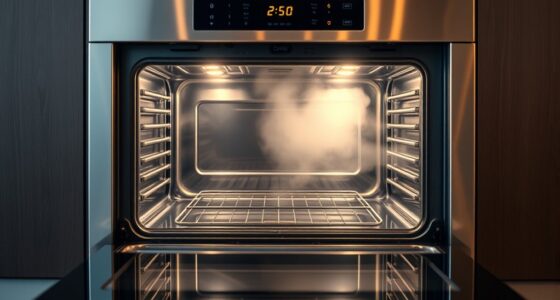To keep your window AC running efficiently, make sure airflow is unobstructed by cleaning vents and clearing debris from the outdoor unit. Check and replace or clean filters regularly to improve indoor air quality and prevent system strain. Inspect the drip pan for dirt or blockages to avoid leaks and mold growth. Proper maintenance of these key parts will extend your AC’s lifespan and boost performance—continue with these tips for peak operation.
Key Takeaways
- Ensure unobstructed airflow by cleaning vents, filters, and outdoor condenser to prevent system strain and maintain efficiency.
- Regularly inspect and replace or clean filters to improve indoor air quality and prevent reduced cooling performance.
- Keep the outdoor unit free from debris and ensure proper clearance around the condenser for optimal airflow.
- Clean the drip pan and ensure drain holes are clear to prevent water leaks and mold growth inside the unit.
- Schedule routine maintenance to monitor airflow, filter condition, and drip pan cleanliness for long-lasting AC performance.

Are you getting the most out of your window AC unit? If you want it to run efficiently and last longer, paying attention to airflow, filters, and drip pans is crucial. Proper airflow ensures your unit cools your space evenly and avoids unnecessary strain on the system. Check that nothing blocks the vents or obstructs the outdoor condenser. Clear pathways allow air to circulate freely, which helps the compressor and fan work effectively. If airflow is restricted, your AC has to work harder, increasing energy consumption and wear. Regularly inspect the vents inside your room and the exterior grille to keep them free of dust, debris, or obstructions. Using a vacuum or a damp cloth to remove dust from these areas can markedly improve airflow and cooling performance. Additionally, ensuring the outdoor unit is free from leaves and other debris can help maintain optimal airflow.
Filters are your AC’s first line of defense against dirt, pollen, and dust. Over time, they trap particles that can clog the system and reduce airflow. If your filters are dirty or clogged, your AC will struggle to cool effectively, and you might notice increased energy bills. Make it a routine to check the filters at least once a month during peak use. Depending on your unit, you might need to replace or clean them. Washable filters can be rinsed with water and dried thoroughly before reinstalling. Disposable filters should be replaced according to the manufacturer’s instructions. Keeping filters clean not only improves airflow but also helps maintain indoor air quality, which is crucial if you or family members suffer from allergies or respiratory issues.
Another often overlooked component is the drip pan, located beneath the evaporator coil. Its job is to catch condensation that forms during cooling. If the drip pan becomes dirty or clogged, it can lead to water leaks or mold growth, both of which can damage your unit and compromise indoor air quality. Regularly inspect the drip pan, especially during the cooling season. Remove any accumulated debris or dirt, and clean it with a mild disinfectant if needed. Check that the drain holes are clear so that water can flow freely to the exterior drain hose. Neglecting this can cause water to overflow, potentially damaging your window frame or creating a mold problem inside your home. Maintaining proper airflow, filters, and drip pans is essential for preventing system malfunctions and prolonging your AC’s lifespan.
Frequently Asked Questions
How Often Should I Replace My Window AC Filters?
You should replace your window AC filters every 1 to 3 months, depending on usage and air quality. If you have allergies or pets, change them more frequently. Check the filters regularly; if they look dirty or clogged, replace them sooner. Keeping filters clean improves airflow, efficiency, and air quality. Regular maintenance guarantees your unit runs smoothly and prolongs its lifespan, saving you time and money in the long run.
Can I Clean My Drip Pan Without Turning off the Unit?
You shouldn’t clean your drip pan without turning off the unit, like trying to patch a leaky boat while it’s still afloat. Power down your AC first to avoid electrical shocks or water damage. Once off, gently remove and clean the pan with a mixture of soap and water. This keeps your unit running smoothly, preventing mold and water buildup that could turn your cool oasis into a swamp.
What Is the Best Way to Improve Airflow in My Window AC?
To improve airflow in your window AC, start by ensuring the vents are fully open and unobstructed. Clean or replace the filters regularly to prevent dust buildup, which can restrict airflow. Check for any debris blocking the vents or fans, and remove it. Make sure the unit is installed level and securely, as tilt can affect airflow. Finally, consider installing a fan nearby to help circulate the cooled air more effectively.
How Do I Detect if My Window AC Has a Refrigerant Leak?
You can detect a refrigerant leak by checking for a noticeable decline in cooling performance, even when the unit runs continuously. Look for ice buildup on the coils, which indicates low refrigerant levels. You might also hear hissing sounds or smell chemical odors around the unit. If you suspect a leak, it’s best to call a professional technician to perform a leak test and safely recharge the refrigerant.
Are There Eco-Friendly Alternatives to Traditional AC Filters?
You can use eco-friendly filters like those made from sustainable materials such as bamboo or recycled plastics. For example, a homeowner switched to a biodegradable filter, reducing plastic waste and improving air quality. These filters effectively trap dust and allergens without harmful chemicals. While they may need replacing more often, they’re better for the environment and your health, making them a smart, eco-friendly alternative to traditional filters.
Conclusion
Keeping your window AC in top shape isn’t just about clean filters or clear drip pans; it’s about ensuring cool comfort when you need it most. Neglecting airflow or ignoring maintenance can turn a invigorating escape into a frustrating ordeal. So, while your unit works tirelessly to beat the heat, remember that a little upkeep can make all the difference. Don’t let small issues turn into big problems—stay proactive, and enjoy cool, worry-free days ahead.









